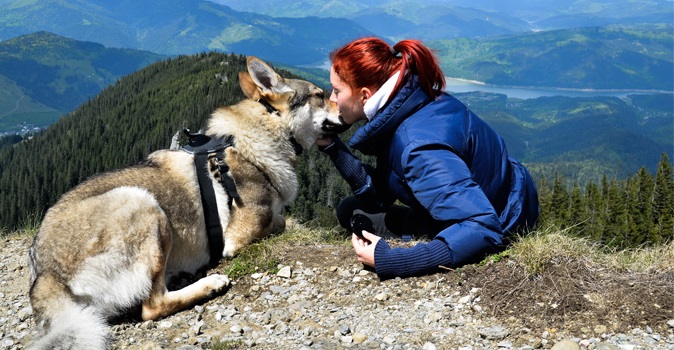Traveling internationally with your dog might be a dream come true. After all, no one wants to leave man’s best friend behind. And the thought of boarding your dog in a kennel might break your heart – and your wallet.
But preliminary research on flying overseas with your dog may leave you feeling overwhelmed. If that’s the case, you’ve come to the right place. This guide to traveling internationally with your dog lays out everything you need to know to help you land on all fours.
Research Your Destination
Every country has its own set of rules and regulations regarding pet immigration. But no matter where you go, your dog must have their rabies shot on record.
When your dog had their last rabies shot is vital. Some countries will not allow your dog to enter if they got their rabies shot less than 30 days before travel, or more than 12 months before travel.
Some countries also require your dog to receive a tapeworm treatment 24 to 120 hours before your trip.
Explore this helpful list of countries’ rules and regulations for importing a dog.
Doggy Quarantine
Depending on whether your destination falls into the category of rabies-free, rabies-controlled, or rabies-high, your dog may need to be quarantined on arrival.
Keep in mind: quarantines are not doggy prisons. They are boarding facilities where dogs are taken care of by professional staff. They have time to run and play in the yard, and you can even visit your pet at most quarantine facilities once per day.
Check this list to see whether your dog will need to be quarantined, and if so, for how long.
Research Airline Regulations for Traveling with Pets
Next, you’ll want to be sure you’re booking your flight with an airline that allows pets. Some airlines do not allow pets at all, while others allow them for a fee.
PRO TIP: If you have a layover, make sure your connecting flight also allows pets.
Some airlines only allow one or two pets on board at a time. Before booking your flight, call the airline to reserve a seat for your dog.
Review this list of all the airlines that will accept your dog. The list includes each airline’s pet transport fee.
Be Aware of the Airline’s Rules on Cabin vs. Cargo
Typically, airlines that allow pets permit dogs under 20 pounds to fly in the cabin. Dogs over 20 pounds are often required to fly as excess cargo.
Popular airlines like Delta and United have specific pages designated for animal travel information. Delta no longer transports pets as cargo, as this is one of the most dangerous methods of flying for pets. Instead, your dog will be on board in the main cabin with you for the duration of your flight.
United offers the alternative option of shipping your pet through its PetSafe cargo.
(Learn more about common issues and accidents and see tips for keeping your dog safe and comfortable below.)
Gather the Essential Paperwork & Your Pet Passport
Now that you know what to expect from your airline and destination, it’s time to start compiling your dog’s documentation.
A pet passport is an easy way to keep all your dog’s paperwork together in one handy location.
A pet passport is much like a human's in the sense that it provides the necessary information for traveling legally overseas. It includes all medical information, such as current vaccinations, and notes whether your dog has any serious health issues.
Take your dog to the veterinarian at least a month before your trip to update their shots and get your paperwork in order.
Prepare for Your Trip: Common Issues & Accidents When Traveling with a Dog
It’s important to prepare yourself for issues that could occur during travel. Below, you’ll learn how to deal with potential delays, missed connections, and accidents that could impact your trip with your pet.
Delays
Any international traveler knows how common (and frustrating) delays are. But when you have a pet, a delay is a cause for concern.
If your dog is traveling as excess cargo, they may be left underneath the plane in a non-pressurized cabin. The temperature, with no fresh air, can fluctuate drastically.
Prepare for a delay by giving your dog plenty of frozen water and blankets in their crate. If your plane does get delayed, inform the airline that your dog is traveling in the cargo area and needs to be removed quickly.
Missed Connections
If you have a connecting flight, your dog's crate may not get reloaded.
While this is a very rare occurrence, it’s wise to remind the airline that you are traveling with your dog. The airline attendants can double-check to make sure your furry friend is safely onboard before takeoff.
Carry a photo of your dog and a form of identification to claim them in case they get lost. Make sure your dog has tags on their collar before boarding to prevent any issues. Most airlines require tags or an identification chip before boarding.
Accidents and Injuries
International travel has its risks. If you’re traveling with only your four-legged companion, it’s wise to consider how you’d care for your dog if you were to face an injury or illness requiring hospitalization.
A travel health insurance plan like Atlas Travel can cover you for unexpected injury or illness incurred abroad, in addition to helping your dog get home safely in case of an emergency. If you’re traveling alone and your hospitalization will result in your dog being left unattended for over 36 hours, Atlas Travel’s Pet Return benefit will pay to return your dog to your home country to be cared for by friends or family while you recover.
If you are eligible for this benefit, WorldTrips will coordinate and pay for the necessary travel arrangements for your pet (up to the $1,000 benefit maximum).
Learn how other Atlas Travel emergency benefits work in a crisis or see a full list of benefits that can cover you as you travel internationally with your dog.
Flying Internationally with Your Dog: Increasing Their Safety & Comfort
Most airlines that allow dogs to be in the cabin require them to remain crated during the flight. Crates should be small enough to fit under the seat in front of you, but large enough that your pet can stand, sit, and lie down.
Larger dogs may be required to be boarded under the plane as excess cargo. This may be stressful for you and your dog. We’ll share tips and tricks to make the journey less jarring for you and your pup below.
Find the Right Kennel
Ensure that your dog’s crate is sturdy and large enough for them to lay down comfortably. It shouldn’t be so large that they could topple over during turbulence and hurt themselves.
Refer to this crate guide to purchase the perfect crate for traveling overseas with your dog.
Before you fly, let your dog use the kennel at home, or as a seat during drives to the dog park. Let it become a safe and familiar place beforehand so they can feel secure on their flight.
Keep Your Dog Hydrated, Fed, and Soothed
Some airlines may not allow you to feed your dog during the flight. If you can, bring their favorite treats or other familiar food. For dogs loaded as cargo, leave some in their crate.
A handy way to hydrate your dog is to freeze water in a plastic bowl and place it in their crate. This prevents water from spilling since it will melt slowly.
Don’t forget to pack your dog’s favorite toy or blanket. A comforting blanket or familiar toy will reduce your dog’s stress level if you can’t be with them.
Should I Use Tranquilizers on My Dog?
The American Veterinary Medical Association advises against the use of tranquilizers while flying internationally with your dog. Sedatives and tranquilizers can cause respiratory and cardiovascular problems as the air pressure changes.
Don’t forget there is often turbulence during flights. If your drowsy dog is in the baggage area, they could fall and hurt themselves in their crate.
Whether you decide to sedate your dog or not, place extra padding and blankets inside their crate to prevent sliding and allow them to sleep on a softer surface.
How Traveling with Dogs Internationally Works: Paws on the Ground
The adventure doesn’t stop once you and your dog are on the ground. Just like at home, you want to protect your dog from danger and maximize their fun.
Be prepared with everything you might need so you can explore more and worry less.
Identification Is Crucial
Be sure your dog has a name tag on their collar. This name tag should include your phone number and email address in case you can’t be reached internationally by phone. Also include your dog’s most recent rabies vaccine tag.
Today, dogs traveling internationally are usually required to have a microchip, either by the airline or your destination country. If your dog gets lost, an animal shelter or vet will be able to scan their microchip and reveal their unique identification number.
Always carry a photo of your dog with you in case they run away and you need to prove you are the owner. Tuck it inside your wallet or purse or keep photos of your pet on your mobile phone (which we’re guessing you already do!).
Make a Doggy Travel Pack
A doggy pack consists of all the essentials needed while on the road. This means food, treats, medications, first-aid, a toy, and water.
If medications need to be kept cool, use an ice pack.
Your doggy travel pack should be small enough to fit inside the bag you're already carrying. Plastic bags are useful for storing food items. A first-aid kit will benefit both you and your dog if something were to happen. Always include medications in case of an emergency.
Include your dog's passport as well, which should contain their medical and travel records.
Keep Your Dog on a Leash
Even if you have a well-trained dog, keep them on a leash. This will prevent them from running off during any unforeseen circumstances.
Many foreign countries have large populations of stray dogs (a situation that the National Animal Interest Alliance deems a crisis).
A leash will help protect your dog, and other dogs, from unwanted encounters. Not every dog enjoys the company of another animal. Using a leash can prevent bites or wounds from another animal, including strays and wildlife, which may have rabies or other infectious diseases.
Learn more about cultural differences you should expect with our Ultimate Guide to International Travel.
Schedule Time to Rest
Any traveling dog will need to rest, especially after they have been sight-seeing with you all day.
You know your doggie best, but their behavior may be less predictable considering the excitement of traveling overseas. Pay attention to your dog’s behavior and be sure to stop and take a break if they seem slow or lethargic.
Always keep water in your doggy pack, especially during hot days full of constant motion. Hydration prevents your dog from overheating and can help you avoid having to make an unexpected visit to the local veterinarian.
Avoid Stressful Situations
You’ll likely come across large groups of people while traveling. If your dog is not comfortable with strangers, they may become stressed by a large body of excited people swarming the two of you.
Remember to put your dog's needs first. Your dog cannot tell you with words that they’re unhappy. Pay close attention to their body language to tell if they’re upset.
Watch What Your Dog Eats
On vacation, you will be devouring all the new delicacies offered. However, you have to make sure your dog does not partake in the food experiment. Dog food isn’t the same in every country. And just as your body may need time to adjust to new food, your dog’s stomach may as well.
Stick to your dog's usual diet. Those puppy dog eyes are tough to resist, but it will be safer for them in the end.
Pay attention to anything lying around on the streets while you walk your pet in a new foreign location. This includes random objects that your dog might mistake for food, like paper or broken glass.
Establish Your Dog's Flea & Tick Defense
If you are traveling to a more remote location for hiking or camping, planning for ticks and other insects is a must. They can transfer diseases to your dog, which could cause lasting medical issues.
After hiking out in the wilderness or tall grass, check yourself and your dog for ticks. Removing them will prevent the transmission of unwanted illnesses.
Make sure to read up on the different types of ticks and insects which carry diseases. It never hurts to ask locals, as well. They will know better than anyone how to avoid running into any disease-ridden bugs in their country.
Restrain Your Pet While Driving
For you and your pet’s safety, restrain your dog in a seat while driving. This will prevent them from sustaining injuries during an accident or sudden stops.
There are multiple different types of restraints that you can use. Choose one that is comfortable and that fits your dog properly.
You can also keep your dog behind a dog guard or in a safely-positioned dog crate or carrier. Whatever method you choose, introduce it to your dog prior to the start of your travels. Take them on a short trip at first, and slowly work you way up to a longer trip.
Returning to the U.S. with Your Dog
For U.S. travelers, returning with your dog after being overseas will be similar to traveling internationally with your dog.
The U.S. Centers for Disease Control and Prevention (CDC) state that your dog must appear healthy before entering the country. If you’re returning from a high-risk country for rabies, you must have a valid rabies vaccination certificate handy.
Have Fun with Fido
Hopefully this guide to traveling internationally with your dog has alleviated your fears and prepared you for your trip. If you take all the necessary precautions, you and your dog should have the trip of a lifetime.
Now get out there and enjoy the adventure!




